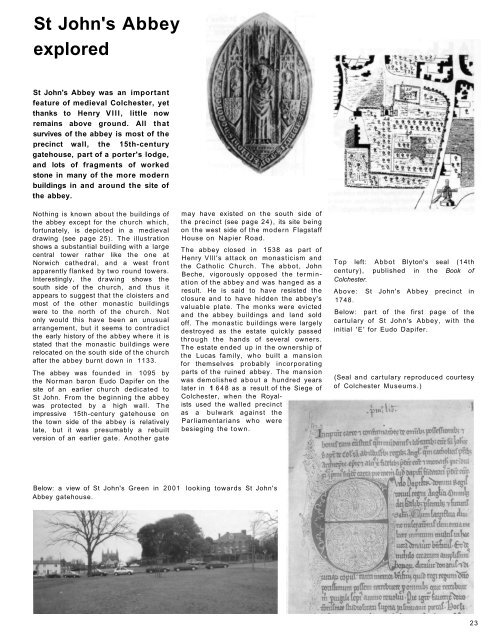The Colchester Archaeologist 2002 - Colchester Archaeological Trust
The Colchester Archaeologist 2002 - Colchester Archaeological Trust
The Colchester Archaeologist 2002 - Colchester Archaeological Trust
Create successful ePaper yourself
Turn your PDF publications into a flip-book with our unique Google optimized e-Paper software.
St John's Abbey<br />
explored<br />
St John's Abbey was an important<br />
feature of medieval <strong>Colchester</strong>, yet<br />
thanks to Henry VIII, little now<br />
remains above ground. All that<br />
survives of the abbey is most of the<br />
precinct wall, the 15th-century<br />
gatehouse, part of a porter's lodge,<br />
and lots of fragments of worked<br />
stone in many of the more modern<br />
buildings in and around the site of<br />
the abbey.<br />
Nothing is known about the buildings of<br />
the abbey except for the church which,<br />
fortunately, is depicted in a medieval<br />
drawing (see page 25). <strong>The</strong> illustration<br />
shows a substantial building with a large<br />
central tower rather like the one at<br />
Norwich cathedral, and a west front<br />
apparently flanked by two round towers.<br />
Interestingly, the drawing shows the<br />
south side of the church, and thus it<br />
appears to suggest that the cloisters and<br />
most of the other monastic buildings<br />
were to the north of the church. Not<br />
only would this have been an unusual<br />
arrangement, but it seems to contradict<br />
the early history of the abbey where it is<br />
stated that the monastic buildings were<br />
relocated on the south side of the church<br />
after the abbey burnt down in 1133.<br />
<strong>The</strong> abbey was founded in 1095 by<br />
the Norman baron Eudo Dapifer on the<br />
site of an earlier church dedicated to<br />
St John. From the beginning the abbey<br />
was protected by a high wall. <strong>The</strong><br />
impressive 15th-century gatehouse on<br />
the town side of the abbey is relatively<br />
late, but it was presumably a rebuilt<br />
version of an earlier gate. Another gate<br />
may have existed on the south side of<br />
the precinct (see page 24), its site being<br />
on the west side of the modern Flagstaff<br />
House on Napier Road.<br />
<strong>The</strong> abbey closed in 1538 as part of<br />
Henry Vlll's attack on monasticism and<br />
the Catholic Church. <strong>The</strong> abbot, John<br />
Beche, vigorously opposed the termination<br />
of the abbey and was hanged as a<br />
result. He is said to have resisted the<br />
closure and to have hidden the abbey's<br />
valuable plate. <strong>The</strong> monks were evicted<br />
and the abbey buildings and land sold<br />
off. <strong>The</strong> monastic buildings were largely<br />
destroyed as the estate quickly passed<br />
through the hands of several owners.<br />
<strong>The</strong> estate ended up in the ownership of<br />
the Lucas family, who built a mansion<br />
for themselves probably incorporating<br />
parts of the ruined abbey. <strong>The</strong> mansion<br />
was demolished about a hundred years<br />
later in 1 648 as a result of the Siege of<br />
<strong>Colchester</strong>, when the Royalists<br />
used the walled precinct<br />
as a bulwark against the<br />
Parliamentarians who were<br />
besieging the town.<br />
Top left: Abbot Blyton's seal (14th<br />
century), published in the Book of<br />
<strong>Colchester</strong>.<br />
Above: St John's Abbey precinct in<br />
1748.<br />
Below: part of the first page of the<br />
cartulary of St John's Abbey, with the<br />
initial 'E' for Eudo Dapifer.<br />
(Seal and cartulary reproduced courtesy<br />
of <strong>Colchester</strong> Museums.)<br />
Below: a view of St John's Green in 2001 looking towards St John's<br />
Abbey gatehouse.<br />
23

















